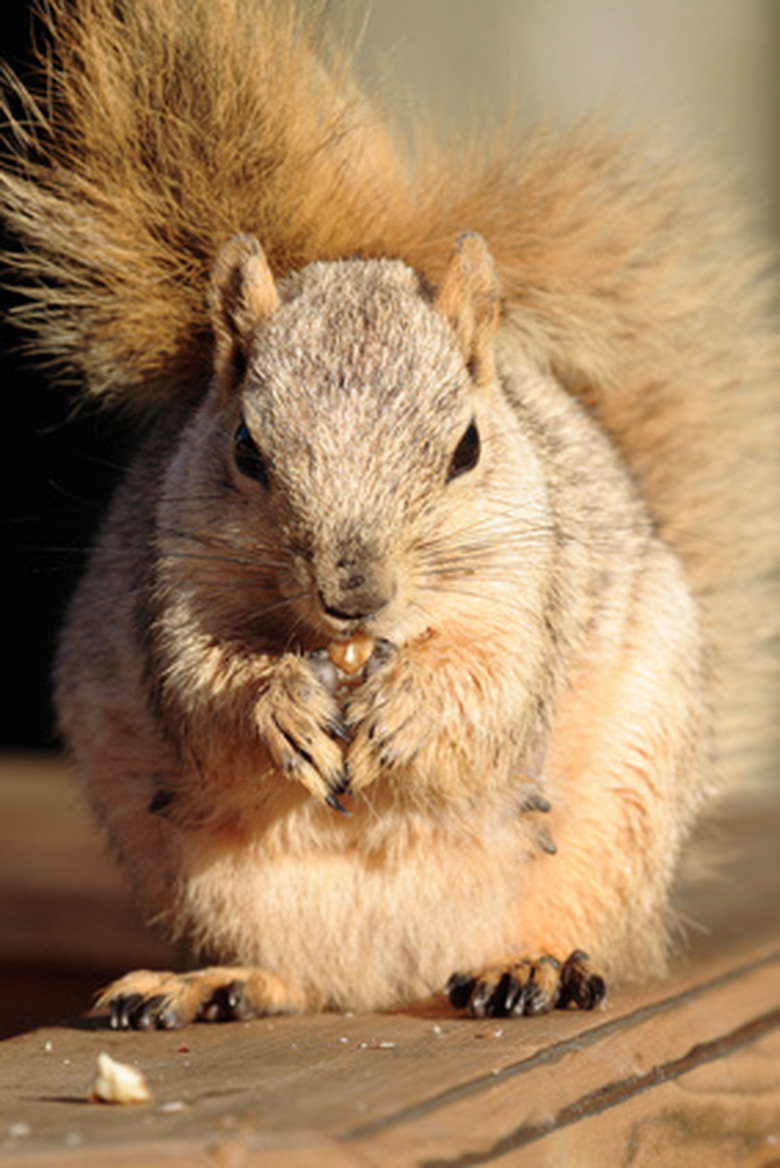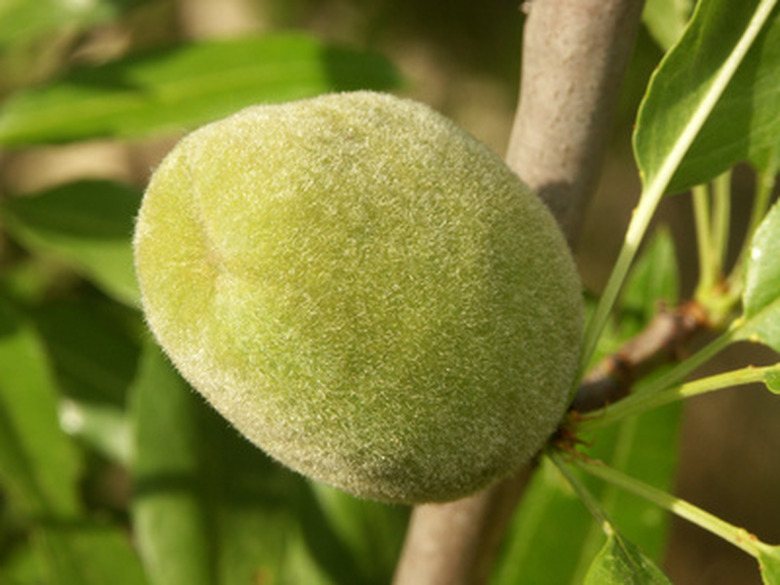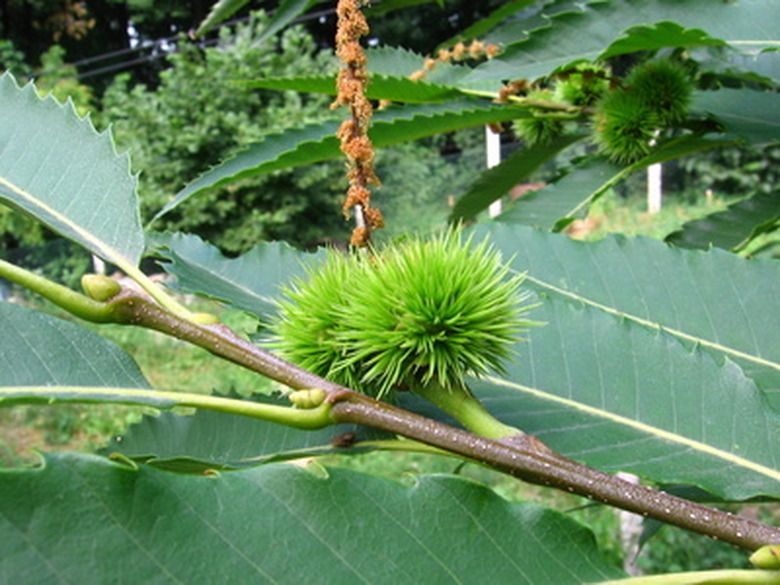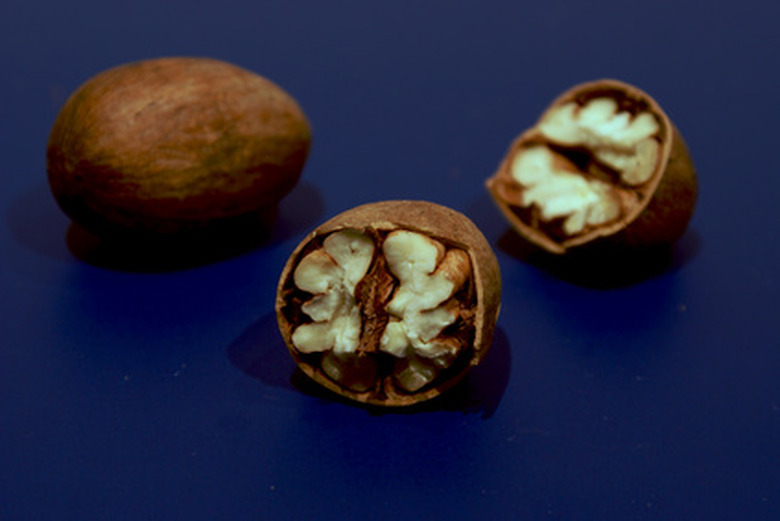How To Identify Nut Trees
Many types of nut trees exist, but the most common types include almond, butternut, chestnut, hickory, pecan and walnut. Identify types of nut trees by the characteristics of their leaves, flowers and nuts, as well as their size and form. A tree field guidebook can help you in properly identifying nut trees, especially during the non-fruiting or non-flowering seasons. Purchase or borrow a field guidebook from your local agricultural extension office or from organizations like the Arbor Day Foundation.
Step 1
Identify almond trees by their rounded shape, reaching 15 to 20 feet tall and 10 to 15 feet wide. Almond trees have pale pink spring flowers and dark-green, alternate, 3- to 6-inch-long leaves with fine-toothed margins. Almonds produce fuzzy drupes that look like immature peaches; the hard, thick-shelled nuts are inside.
- Many types of nut trees exist, but the most common types include almond, butternut, chestnut, hickory, pecan and walnut.
- A tree field guidebook can help you in properly identifying nut trees, especially during the non-fruiting or non-flowering seasons.
Step 2
Identify butternut trees by their rounded shape, growing 40 to 60 feet tall and 35 to 50 feet wide. Butternut trees have compound leaves growing in 11 to 19 leaflets on a single stem, which are dark-green with fine hairs. Butternuts bloom from late May to early June with yellowish-green flowers, followed by oblong, 1½- to 2½-inch fruits covered with sticky hairs.
Step 3
Look for a nut tree that's 40 to 60 feet tall and wide with cream-colored or pale yellow flowers that bloom in early summer. This is the Chinese chestnut. The chestnut tree has alternate, dark-green, 3- to 5-inch-long leaves that are shiny on the upper sides with toothed edges. Each prickly seed husk is up to 3½ inches long and contains up to four brown nuts.
- Identify butternut trees by their rounded shape, growing 40 to 60 feet tall and 35 to 50 feet wide.
- The chestnut tree has alternate, dark-green, 3- to 5-inch-long leaves that are shiny on the upper sides with toothed edges.
Step 4
Identify the 60- to 80-foot tall and 40-foot wide shellbark hickory by its greenish-colored springtime flowers and 10- to 24-inch compound leaves that sprout five to nine leaflets on a single stem that are dark yellowish-green on the upper sides. The shellbark hickory produces large, oval fruits in the fall with ¼-inch-thick husks enclosing a light-brown, ribbed nut shell.
Step 5
Look for a 70- to 100-foot tall and 40- to 75-foot wide tree with yellow or greenish-yellow flowers and compound, 12- to 20-inch-long leaves to identify the pecan. The leaves are shiny and dark-green, sprouting odd-numbered leaflets that are each about 4 to 8 inches long. The pecan tree produces clustered fruits with angled husks in clusters that turn from yellowish-green to brown as they mature.
Step 6
Identify the black walnut tree by its 50- to 75-foot height and spread. The black walnut tree has greenish springtime blooms and compound, alternate, 1- to 2-foot-long leaves that contain 15 to 23 dark-green, fine-toothed leaflets. The fruits are round with green husks, beneath which are thick, hard and ridged black nut shells.
- Identify the 60- to 80-foot tall and 40-foot wide shellbark hickory by its greenish-colored springtime flowers and 10- to 24-inch compound leaves that sprout five to nine leaflets on a single stem that are dark yellowish-green on the upper sides.
- The black walnut tree has greenish springtime blooms and compound, alternate, 1- to 2-foot-long leaves that contain 15 to 23 dark-green, fine-toothed leaflets.
Tip
Hazelnuts are technically shrubs that reach only 15 to 18 feet tall and 10 to 12 feet wide. The female hazelnut flowers are red and bloom in mid-winter to early spring.
Warning
Don't confuse the black walnut tree with the Carpathian English walnut, which has compound leaves with only five to nine leaflets and bears green-husked fruits in clusters of three to nine. The inner nut shell is thinner than the black walnut tree's nuts.



